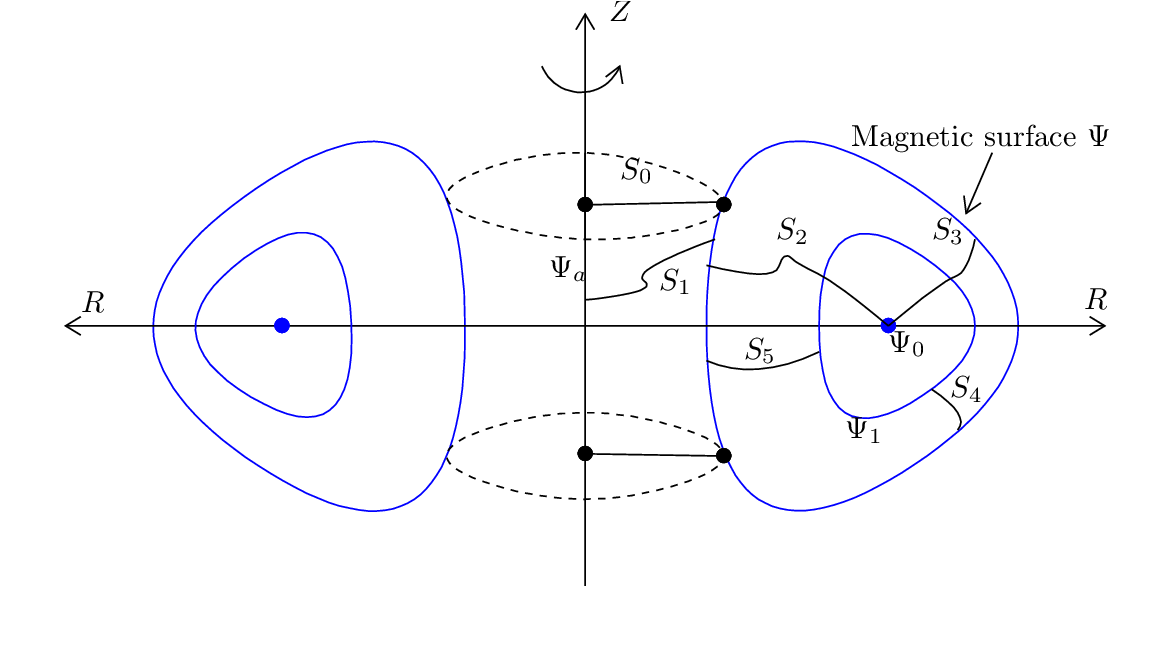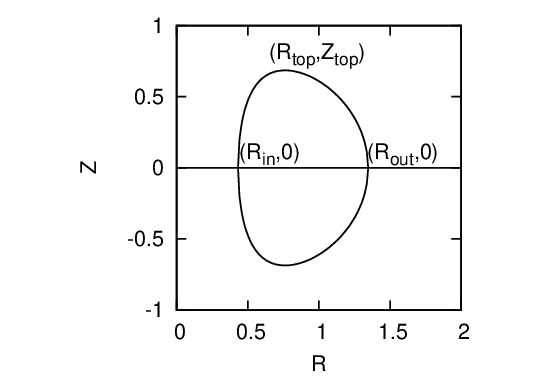
In most part of a tokamak plasma, the contours of Ψ on (R,Z) plane are closed curves. As discussed above, the contours of Ψ are the projection of magnetic lines on the poloidal plane. Closed contours of Ψ implies closed magnetic surfaces, as shown in Fig 3.

The innermost magnetic surface reduces to a curve, which is called magnetic axis (in Fig. 3, Ψ0 labels the magnetic axis). Because the magnetic axis is the point of maximum/minimum of Ψ(R,Z), the value of ∇Ψ is zero at the magnetic axis. As a result, the poloidal component of the equilibrium magnetic field is zero on magnetic axis (refer to Eq. (10)), i.e., the magnetic field has only toroidal component there.
As discussed in Sec. 1.7, the poloidal magnetic flux enclosed by a magnetic surface Ψ (the poloidal magnetic flux through the toroidal surfaces S2) is given by
 | (27) |
where Ψ0 is the value of Ψ at the magnetic axis. Here the positive direction of the surface S2 is defined
to be in the clockwise direction when an observer looks along the direction of  . In practice, we need to
pay attention to the positive direction of the toroidal surface used to define the poloidal flux (there can
be a sign difference when choosing different positive directions). Also note, in tokamak
literature, the poloidal magnetic flux enclosed by a closed magnetic surface can have two
different definitions, one of which is the the poloidal magnetic flux through the surface S2 in
Fig. 3, the other one is the poloidal magnetic flux through the central hole of the magnetic
surface, i.e., the poloidal flux through S1 in Fig. 3. The former definition is adopted in this
article, except explicitly specified otherwise. In the latter case, the poloidal magnetic flux is
written
. In practice, we need to
pay attention to the positive direction of the toroidal surface used to define the poloidal flux (there can
be a sign difference when choosing different positive directions). Also note, in tokamak
literature, the poloidal magnetic flux enclosed by a closed magnetic surface can have two
different definitions, one of which is the the poloidal magnetic flux through the surface S2 in
Fig. 3, the other one is the poloidal magnetic flux through the central hole of the magnetic
surface, i.e., the poloidal flux through S1 in Fig. 3. The former definition is adopted in this
article, except explicitly specified otherwise. In the latter case, the poloidal magnetic flux is
written
 | (28) |
where the positive direction of the surface S1 is defined to be in the clockwise direction.
Also note that, since the poloidal magnetic field can be written as Bp = ∇Ψ ×∇ϕ, the condition ΨLCFS − Ψaxis > 0 means Bp points in the anticlockwise direction (viewed along ϕ direction), and ΨLCFS − Ψaxis < 0 means Bp points in the clockwise direction.
Let us introduce parameters characterizing the shape of a magnetic surface in the poloidal plane. The “midplane” is defined as the plane that passes through the magnetic axis and is perpendicular to the symmetric axis (Z axis). For a up-down symmetric (about the midplane) magnetic surface, its shape can be roughly characterized by four parameters, namely, the R coordinate of the innermost and outermost points in the midplane, Rin and Rout; the (R,Z) coordinators of the highest point of the magnetic surface, (Rtop,Ztop). These four parameters are indicated in Fig. 4.

In terms of these four parameters, we can define the major radius of a magnetic surface
 | (29) |
(which is the R coordinate of the geometric center of the magnetic surface), the minor radius of a magnetic surface
 | (30) |
the triangularity of a magnetic surface
 | (31) |
and, the ellipticity (elongation) of a magnetic surface
 | (32) |
Usually, we specify the value of R0, a, δt, and κ, instead of (Rin,Rout,Rtop,Ztop), to characterize the shape of a magnetic surface. The value of the triangularity δt is usually positive in traditional tokamak operations, but negative triangularity is achievable and potentially useful, which is under active investigation.
Besides, using a and R0, we can define another useful parameter 𝜀 ≡ a∕R0, which is called the inverse aspect ratio.
The four shape parameters for the typical Last-Closed-Flux-Surface (LCFS) of EAST tokamak are: major radius R0 = 1.85m (can reach 1.9m), minor radius a = 0.45m, ellipticity κ = 1.8 (can be in the range from 1.7 to 1.9), triangularity δt = 0.6 (can be in the range from 0.5 to 0.7). Note that the major radius R0 of the LCFS is usually different from Raxis (the R coordinate of the magnetic axis). Usually we have Raxis > R0 due to the so-called Shafranov shift.